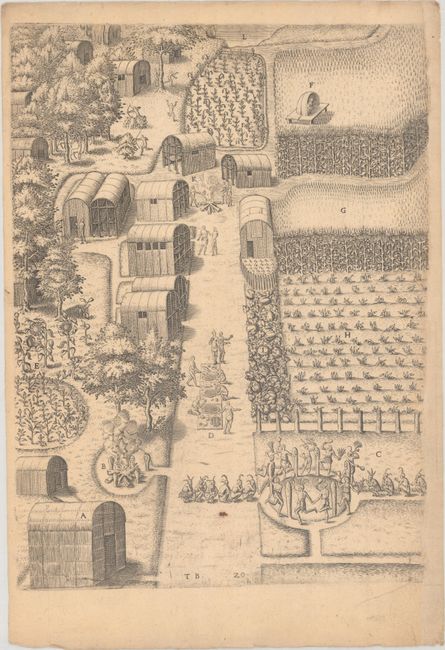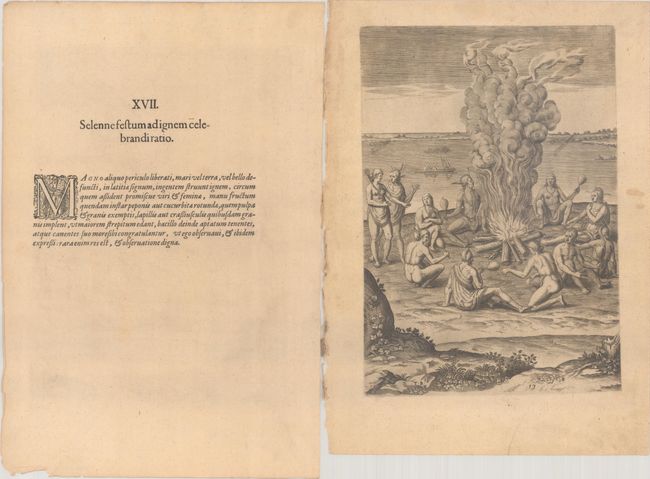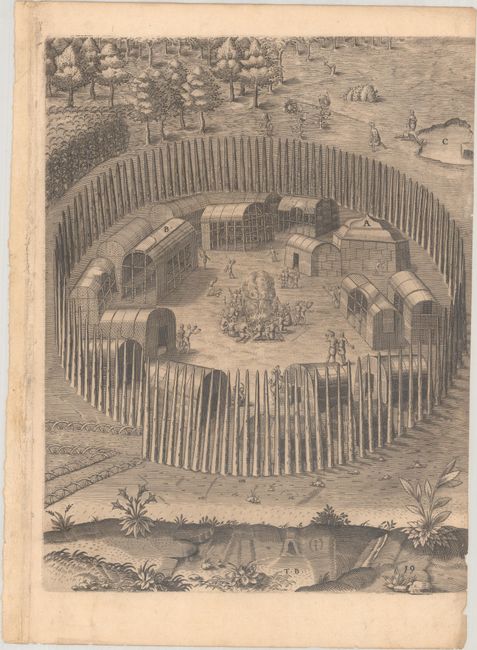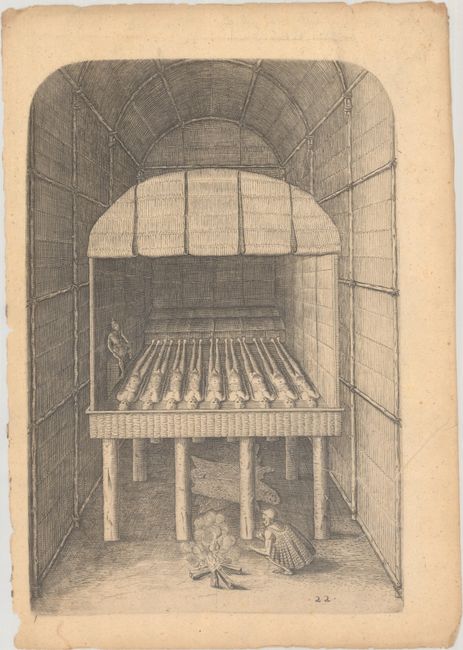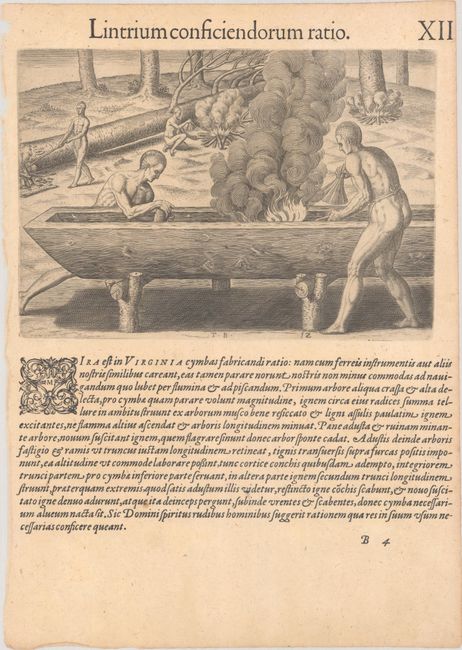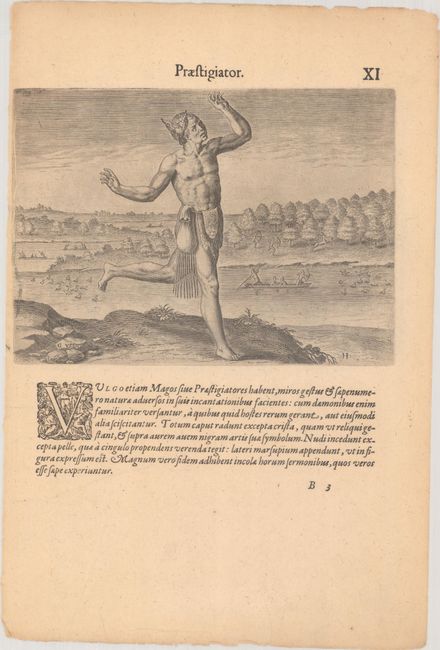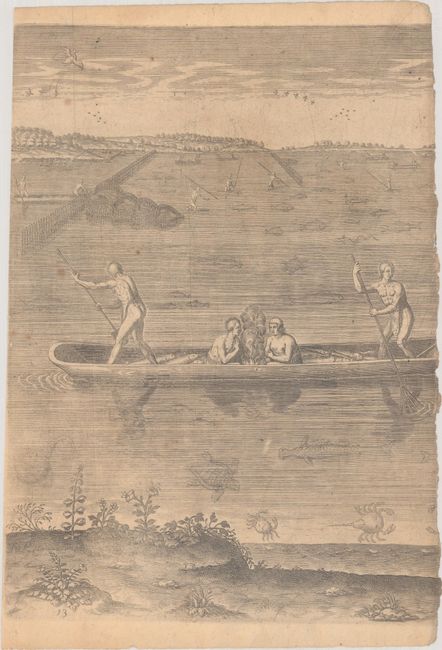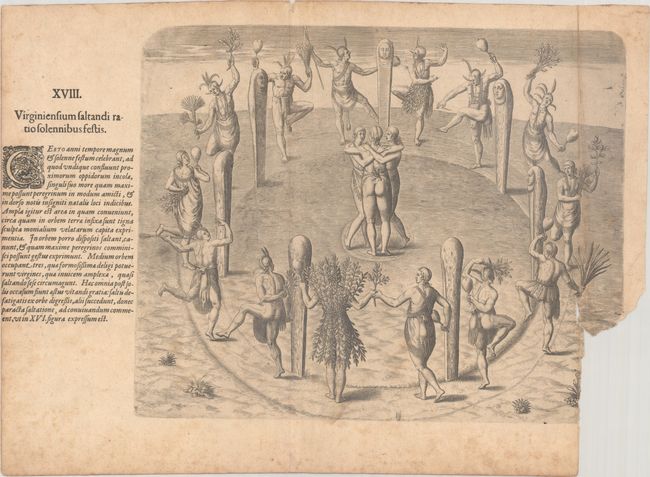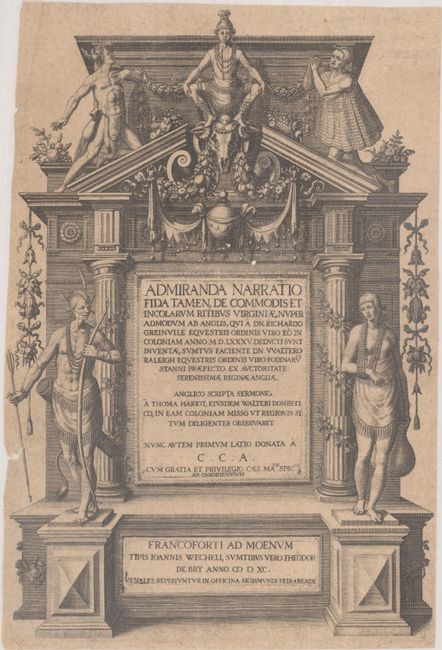Subject: Virginia, Native Americans
Period: 1608 (circa)
Publication:
Color: Black & White
Size:
9.1 x 13.7 inches
23.1 x 34.8 cm
This copper engraving is from a remarkable series of publications, illustrating voyages of discovery and travels of exploration to various parts of the world. The project was begun by Theodore de Bry of Frankfurt, in 1590 and was to continue for another 54 years. They became known collectively as the Grands Voyages (to America and the West Indies) and the Petits Voyages (to the Orient and the East Indies). De Bry died after the first six parts of the Grands Voyages were completed. The project was completed initially by his widow and two sons, Johann Theodore de Bry and Johann Israel de Bry, then by his son-in-law, Matthaus Merian in 1644.
This fascinating lot includes the title page, text, all 22 plates on Virginia Natives, and 5 plates of Picts that were included in the second Latin edition of Part I of de Bry's Grands Voyages. Nearly all pages are from the second edition, first issue, although likely from different examples due to slight inconsistencies in paper sizes. However Plate XII is from the first edition, second issue. This lot does not include the map of Virginia, the frontispiece of Adam and Eve, which was unnumbered but considered to be the first plate, the text pages to Plate XIII or Pict Plate V, or the colophon. Each of the plates is accompanied by Latin text either below the plate or on an opposing page, and all plates have blank versos. The plates depict:
II. The English arrive in Virginia. Condition: Moderate toning and dampstaining. (B)
III. A Weroans, or Chieftain, of Virginia. Condition: Heavy toning outside of engraving. (B)
IIII. One of the Chief Ladies of Secota. Condition: Minor toning at far right. (A)
V. A Secota Priest. Condition: Light foxing. (B+)
VI. A Young Gentlewoman of Secota. Condition: Light soiling. (B+)
VII. A Chief of Roanoke. Condition: Minor foxing. (B+)
VIII. A Noblewoman of Pomeiock. Condition: Light toning. (B+)
IX. An Old Man in Winter Garb. Condition: Light toning and trimmed by the bookbinder to the right edge of the engraving. (B+)
X. How the Chief Ladies of Dasamonquepeio Carry their Children. Condition: Several printer's creases in the engraving. (B+)
XI. The Sorcerer. Condition: A printer's crease at far left. (A)
XII. How They Build Boats in Virginia. Condition: Chips in the left margin. (A)
XIII. How They Catch Fish. Condition: Light foxing, trimmed to the edge of the engraving at left and 1" into the engraving at right. Missing accompanying page of text. (D)
XIIII. How They Cook their Fish. Condition: Moderate toning. (B)
XV. How They Boil Meal in Earthenware Pots. Condition: Minor soiling. (A)
XVI. How They Eat. Condition: Minor soiling and a chip in the left margin that has been professionally repaired. (A)
XVII. Praying Around the Fire with Rattles. Condition: Marginal soiling. (A)
XVIII. The Dances at their Great Feasts. Condition: Light soiling and foxing with a 1" x 3" chip at bottom right. (D)
XIX. The Town of Pomeiock. Condition: Trimmed by the bookbinder at right with loss of about 1 mm. (B+)
XX. The Town of Secota. Condition: Remargined at right with loss of about 2 mm of the image. (B+)
XXI. The Idol Kewas. Condition: Light foxing. (B+)
XXII. The Tomb of the Weroans. Condition: A few small printer's creases at bottom right. (A)
XXIII. The Marks of the Chief Men of Virginia. Condition: Light foxing and minor toning. (B+)
I. Pictiicon. Condition: A bright sheet with light foxing. (B+)
II. Fminae Pictaeicon. Condition: Light foxing with tiny edge tears and chips along the bottom edge of the sheet. (B+)
III. Virginis Pictaeicon. Condition: Moderate soiling with dampstains in the margins. (B)
IIII. Alterius viri Pictis Viciniicon. Condition: Foxing and a few small worm tracks in the blank margins, with dampstains that enter the image at top right. (B+)
V. Feminae Pictis Vicinaeicon. Condition: Minor staining in the left margin. (A)
References: Church #142.
Condition:
See above for condition grade of each plate. The title page is trimmed close to the edge of the engraving, and has a 1 cm tear at left. The text has light toning and faint dampstains along the edges of the sheets.


